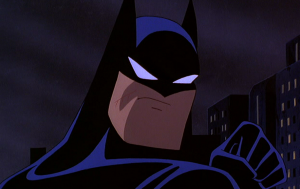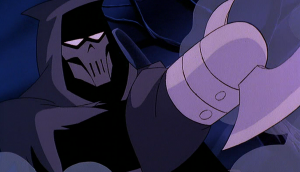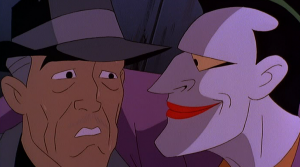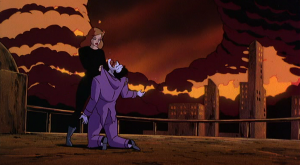Quick Note: This is a rewrite of something I wrote a few years back. I was watching the film again and it dawned on me how much I loved it. I’ve expanded a lot of sections and improved the grammar as best as possible.
1992 would see Tim Burton’s Batman sequel hit cinemas as Bruce Timm’s animated series debuted on TV. Batman: The Animated Series would become viewed as a landmark in children’s entertainment and its success would spur on the development of a big screen animated outing the following year. Batman: Mask of the Phantasm’s surprisingly adult plot would be indicative of the series as a whole which infused the pulp character with humanity and intelligence.
Running for five years Batman: The Animated Series would eschew the standard practices of children’s cartoons and instead build its own style and iconography. Distinguishing itself from the popular Marvel cartoons of the time Batman: The Animated Series adopted a stylised art-deco look in contrast to its competitor’s attempts at realism. It also used the timelessness of Tim Burton’s Batman films to great effect to create stories that contained modern sensibilities and technology but had the ambience and look of classic noir.
The series also largely eschewed the continuity of the comic books and films presenting classic Batman characters and stories in new and interesting ways. As such Batman: The Animated series would both create and revitalise, adding new villains to Batman’s rogue gallery and giving new context to his existing enemies. The Joker’s psychotic girlfriend Harley Quinn would be a creation of the animated series as would the tragic back story of Mr. Freeze. Previously little more than an outlandish thug with a freeze gun Mr. Freeze would gain a melancholic edge in the cartoons. This facet of his personality and revised back story would be adopted into the comics themselves and would be ultimately used for Joel Schumacher’s fourth entry in the film series Batman and Robin.
“Looks like there’s a new face in Gotham and soon his name will be all over town… to say nothing of his legs, and feet, and spleen, and head…”
The show would also take its time in setting up plot points and situations, a chief example being the use of Harvey Dent a number of episodes prior to his transformation to Two Face. In setting up the character as a friend of Bruce Wayne it granted his cataclysmic turn to darkness a far great emotional impact. This kind of emotional climax was what Batman: The Animated Series was all about with the writers often favouring smaller moments over grander payoffs. The amazing thing about Batman: The Animated Series is that it deftly mixed emotional and physical confrontations, making certain villains almost sympathetic and heightening the terror that Batman instilled in his enemies. It would still have episodes which didn’t work and the resolution to most episodes involved Batman punching things, but the series extended its scope every chance it got.
Instead of simply offering setup for a climatic fight the individual episodes of Batman went in various different directions. Sometimes they would focus on the Batman himself as he went about his detective business, sometimes the focus would fall on a peripheral character with the Dark Knight as a background force. In doing so the series managed to build up a cast of heroes, villains and supporting players that had incredible amounts of depth for a cartoon series and this depth would be employed brilliantly when Mask of the Phantasm tackled the origins of its lead character.
Mask of the Phantasm takes place with Batman fully integrated into the running of Gotham city. His tacit agreement with Commissioner Gordon allows him to track and bring in criminals with impunity. However a new costumed avenger starts to brutally murder mob bosses leading the public, spurred on by ambitious city councilman Arthur Reeves, to view the Batman as the culprit. Hounded by the police as he tries to unravel the identity of the enigmatic crusader Bruce Wayne’s life is turned around by the reappearance of the love of his life Andrea Beaumont. It’s an interesting plotline and it runs against the status quo shown in the Burton and Schumacher films. In those movies Batman is a part of society, a mini-celebrity whose appearance is accepted as necessary by the populace. The Animated series however presented a Gotham which was thankful but uncomfortable with its Dark Knight, a tension encapsulated by the efforts of Bullock (a Gotham detective) to catch Batman. Batman in the films felt like he was part of the establishment, Batman in the cartoons was one mistake away from being ripped apart by Gotham’s citizens.
Andrea’s appearance causes Wayne to reminisce about his past and in doing so we’re given an insight into the birth of Batman. The film switches between the present and the past and as such we’re given a glimpse into Wayne as a fledgling crime fighter, fully trained but lacking the iconography which would make him famous. We see him donned in dark clothes and a balaclava, combating crime but failing to make a psychological impact. We even see Bruce swayed from his quest by his blossoming affections for Andrea. It’s a fascinating insight into the character and it marks the first feature in the series to look at this period. Batman Begins would be a full blown origin story but all the other Batman films up to this point focused on a character that had found and made peace with his identity, a vigilante who had already perfected his craft. Superhero films have often relied on origin stories as a standard template and to be honest I’m feeling something akin to Origin fatigue. Mask of the Phantasm justifies itself however by making the origin tangential to the main plot, it’s not about the construction of the batcave or the donning of the suit but about the choice between happiness and duty that Wayne makes. It is essentially trying to explain the sacrifices he made to become Gotham’s Dark Knight
“So, tell me – with all that money and power, how come you always look like you want to jump off a cliff?”
Like Batman Begins the film would take its inspiration from Frank Miller’s Batman: Year One a one shot comic book which depicted Batman’s fledgling year. Whilst Year One was a far grittier and nastier take on Batman’s first forays into crime fighting its influence can be felt in the way Bruce Wayne interacts with his parents and criminals in Mask of the Phantasm. Whereas earlier films would show Bruce Wayne being spurred on by his parents murder Mask of the Phantasm created the notion that Bruce’s mission was in servitude to them. Certainly his desperate pleas for another option when he finds happiness suggest that this Bruce Wayne could have exorcised his demons without donning the mantle of the bat.
What makes these earlier scenes work is Kevin Conroy’s fantastic performance as both Bruce Wayne and Batman. Conroy’s voice work would be one of the lynchpins of the animated series and his magnetic and divergent turns as Bruce Wayne and Batman would help to create a sympathetic core to a character who could have easily been a silent loner. Conroy would be helped by a large ensemble of fantastic voice actors but the stand out supporting performer would prove to be Mark Hamill. Despite being best known for his heroic turns in the Star Wars trilogy Hamill established a career in his later life as a remarkably talented voice actor, his focus being on characters of the more villainous persuasions. With voice work in everything from Spiderman to Miyazaki’s Laputa: Castle in the Sky Hamill would bring a unique blend of humour and darkness to each of his roles.
But his most famous voice work would be playing Batman’s arch-enemy the Joker in the Animated Series. Clearly enjoying himself immensely Hamill would, with the help of some truly fantastic strips, create a Joker that wasn’t just good for a children’s show but which actually threatened to be one of the most interesting and bravura interpretations of the character. Perfectly capturing the Jokers conflicted and psychotic nature, Hamill was able to be both funny and terrifying at the drop of a hat. With the upcoming Arkham City scheduled to be Hamill’s last performance as the Joker it’s amazing to think that his characterisation is my default view of the character. Now I’m fond of Nicholson’s take on the character, and respect Ledger’s Joker, but there’s something about the gentle contempt in Hamill’s voice that is iconic to me. In a weird way the Joker being constrained to a PG rating for the cartoon actually makes the character feel more dangerous, like the PG rating is the façade hiding the deep madness underneath and Hamill always walked an amazing tightrope between buffoonery and genuine threat.
“Mi casa nostra es su casa nostra.”
The Joker’s appearance halfway through The Mask of the Phantasm should really spell doom for a production already juggling two plotlines, but somehow it manages to handle the flashbacks, the phantasm and Batman’s most iconic showdown with his greatest nemesis incredibly well. Considering its lean runtime and exuberance of Hamill’s performance there was a danger that the Joker would once again dominate proceedings, but whilst the character is exceptionally memorable he’s reined in enough to serve as a suitable heavy without completely destroying the focus of the story.
In fact despite a somewhat episodic nature Mask of the Phantasm manages to have one of best stories in all of the Batman films. Part of this is due to the fact that all three plotlines serve to flesh out one larger story which ties together all of the major and minor characters. In fact one criticism to be levelled against the film is that everything is wrapped up a little too tightly, to the point where the finals final climatic showdown occurs in a ‘World of Tomorrow’ museum which Bruce Wayne and Andrea visited when they were first dating. Simply having the Joker make his hideout at a random museum would have been fine, but by establishing an emotional connection for the other characters it makes everything seem a little trite.
But it really is a minor criticism and the museum provides a fantastic backdrop for one of Batman’s most explosive encounters with the Joker. With Jetpacks, knife wielding robo-housewives, toy biplanes and a fight against the backdrop of a miniature city thrown into the mix the final ten minutes is a suitably cathartic climax to a film that had avoided the usual Batman super heroics.
With a sumptuous score from Shirley Walker and some amazing animation Mask of the Phantasm is a perfect showcase of the style and intelligence that made Batman: The Animated Series so fantastic.
This is my all time favourite Batman film, disagree with my choice? Let me know!



